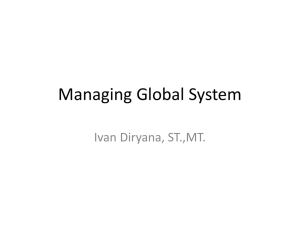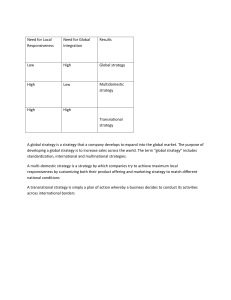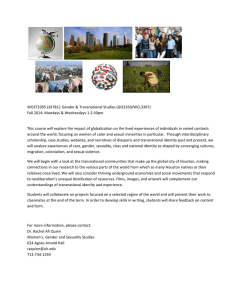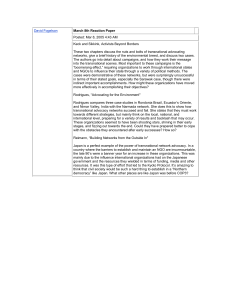Global Information Systems: Internationalization & Challenges
advertisement
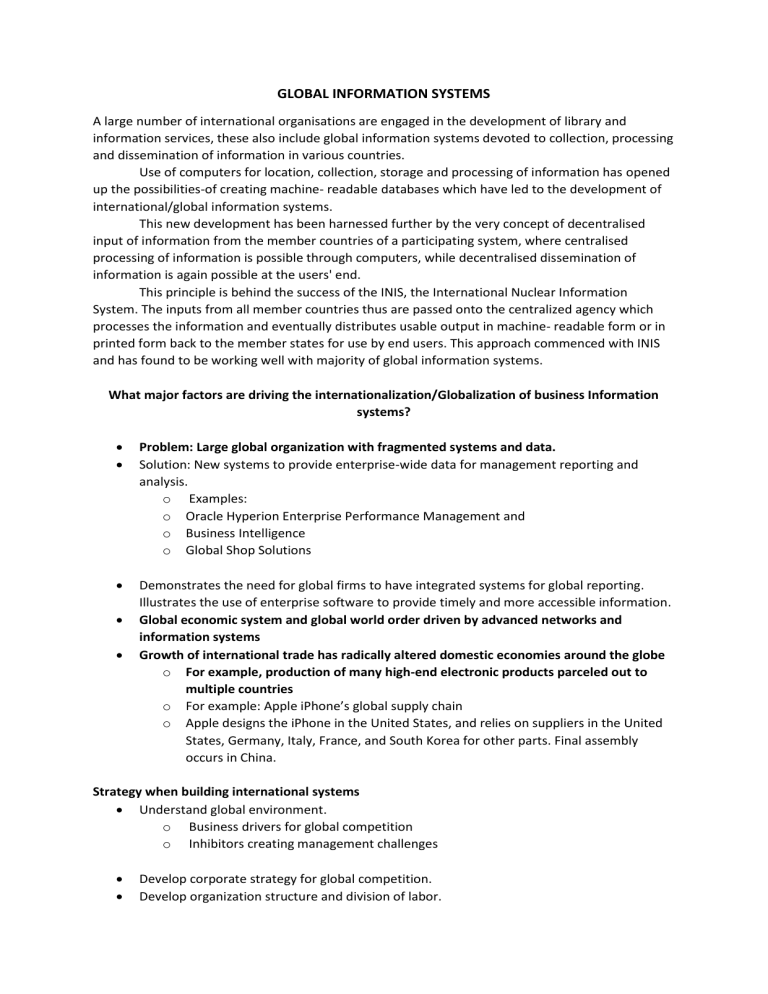
GLOBAL INFORMATION SYSTEMS A large number of international organisations are engaged in the development of library and information services, these also include global information systems devoted to collection, processing and dissemination of information in various countries. Use of computers for location, collection, storage and processing of information has opened up the possibilities-of creating machine- readable databases which have led to the development of international/global information systems. This new development has been harnessed further by the very concept of decentralised input of information from the member countries of a participating system, where centralised processing of information is possible through computers, while decentralised dissemination of information is again possible at the users' end. This principle is behind the success of the INIS, the International Nuclear Information System. The inputs from all member countries thus are passed onto the centralized agency which processes the information and eventually distributes usable output in machine- readable form or in printed form back to the member states for use by end users. This approach commenced with INIS and has found to be working well with majority of global information systems. What major factors are driving the internationalization/Globalization of business Information systems? Problem: Large global organization with fragmented systems and data. Solution: New systems to provide enterprise-wide data for management reporting and analysis. o Examples: o Oracle Hyperion Enterprise Performance Management and o Business Intelligence o Global Shop Solutions Demonstrates the need for global firms to have integrated systems for global reporting. Illustrates the use of enterprise software to provide timely and more accessible information. Global economic system and global world order driven by advanced networks and information systems Growth of international trade has radically altered domestic economies around the globe o For example, production of many high-end electronic products parceled out to multiple countries o For example: Apple iPhone’s global supply chain o Apple designs the iPhone in the United States, and relies on suppliers in the United States, Germany, Italy, France, and South Korea for other parts. Final assembly occurs in China. Strategy when building international systems Understand global environment. o Business drivers for global competition o Inhibitors creating management challenges Develop corporate strategy for global competition. Develop organization structure and division of labor. Consider management issues. o Design of business procedures, reengineering, managing change Consider technology platform. INTERNATIONAL INFORMATION SYSTEMS ARCHITECTURE The major dimensions for developing an international information systems architecture are the lobal environment, the corporate global strategies, the structure of the organization, the management and business processes, and the technology platform. GLOBAL BUSINESS DRIVERS GENERAL CULTURAL FACTORS: Global communication and transportation technologies. Development of global culture. Emergence of global social norms. Political stability. Global knowledge base SPECIFIC BUSINESS FACTORS: Global markets Global production and operations Global coordination Global workforce Global economies of scale Challenges and obstacles to global business systems– General cultural challenges Cultural particularism –Regionalism, nationalism, language differences Social expectations: –Brand-name expectations, work hours Political laws –Transborder data flow –Transborder data and privacy laws, commercial regulations Specific challenges •Standards –Different EDI, e-mail, telecommunication standards •Reliability –Phone networks not uniformly reliable •Speed –Different data transfer speeds, many slower than United States • Personnel –Shortages of skilled consultants. State of the art Most companies have inherited a patchwork international system using traditional batchoriented reporting, manual entry of data from one legacy system to another, and little online control and communication. Significant difficulties in building appropriate international architectures: o Planning a system appropriate to firm’s global strategy. o Structuring organization of systems and business units o Solving implementation issues o Choosing right technical platform Global Information Systems strategies and business organization: Three main kinds of organizational structure Centralized: In the home country Decentralized/dispersed: To local foreign units Coordinated: All units participate as equals Four main global strategies Domestic exporter Multinational Franchisers Transnational Global information systems to fit the strategy –Configuration, management, and development of systems tend to follow global strategy chosen –Four main types of systems configurations: 1. Centralized: Systems development and operation occur totally at domestic home base. 2. Duplicated: Development occurs at home base but operations are handed over to autonomous units in foreign locations. 3. Decentralized: Each foreign unit designs own solutions and systems. 4. Networked: Development and operations occur in coordinated fashion across all units Challenges of Global Information Systems Principle management challenges in developing global systems o –Agreeing on common user requirements o –Introducing changes in business processes o –Coordinating application development o –Coordinating software releases o –Encouraging local users to support global systems Separate regional, national production and marketing centers o Foreign divisions have separate IT systems o E-mail systems are incompatible o Each production facility uses different ERP system, different hardware and database platforms, and so on Global Information systems strategy to overcome the Challenges: 1. Share only core systems: Core systems support functionality critical to firm. 2. Partially coordinate systems that share some key elements: a. Do not have to be totally common across national boundaries b. Local variation desirable 3. Peripheral systems: Need to suit local requirements only 4. Define core business processes. 5. Identify core systems to coordinate centrally. 6. Choose an approach: a. Piecemeal and grand design approaches tend to fail. b. Evolve transnational applications incrementally from existing applications. 7. Make benefits clear: a. Global flexibility b. Gains in efficiency c. Global markets and larger customer base unleash new economies of scale at production facilities d. Optimizing corporate funds over much larger capital base The management solution: Implementation 1. Agreeing on common user requirements a. Short list of core business processes b. Develop common language, understanding of common elements and unique local qualities 2. Introducing changes in business processes a. Success depends on legitimacy, authority, ability to involve users in change design process 3. Coordinating applications development a. Coordinate change through incremental steps b. Reduce set of transnational systems to bare minimum 4. Coordinating software releases a. Institute procedures to ensure all operating units update at same time 5. Encouraging local users to support global systems a. Cooptation: Bringing the opposition into design and implementation process without giving up control over direction and nature of the change i. Permit each country unit to develop one transnational application ii. Develop new transnational centers of excellence Technology challenges of global systems Computing platforms and systems integration o How new core systems will fit in with existing suite of applications developed around globe by different divisions o Standardization: Data standards, interfaces, software, and so on Connectivity o Internet does not guarantee any level of service o Many firms use private networks and VPNs o Low penetration of PCs, outdated infrastructures in developing countries Software o Integrating new systems with old o Human interface design issues, languages o Software localization: converting software to operate in second language Most important software applications: TPS and MIS ,Collaboration tools, email, videoconferencing
